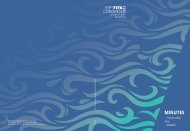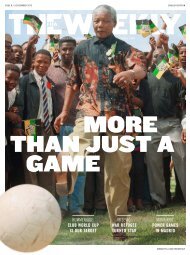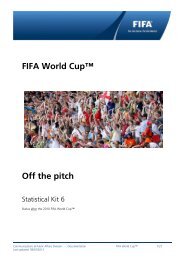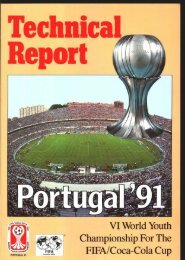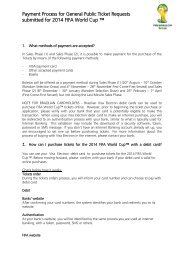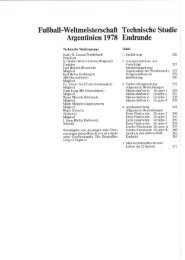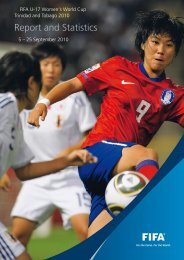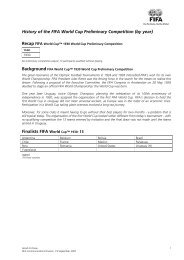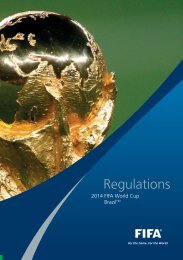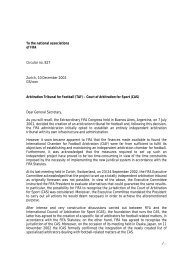You also want an ePaper? Increase the reach of your titles
YUMPU automatically turns print PDFs into web optimized ePapers that Google loves.
Statistics and Team Data<br />
Costa Rica<br />
Costa Rica’s run to the quarter-finals can certainly<br />
be classified as a success. The team’s<br />
game plan was based around a 3-5-2 formation,<br />
and when their opponents moved forward,<br />
the two Costa Rican wing-backs would<br />
invariably fall back to form a line of five at<br />
the back. The three remaining midfielders<br />
would form a line of three in front of the<br />
defence, with extra support from one of the<br />
two attackers. In this way, Costa Rica always<br />
had a <strong>com</strong>pact defence.<br />
The two strikers and two midfielders patrolling<br />
the centre of the pitch were the keys<br />
to Costa Rica’s attacks. The two wing-backs<br />
assumed more of a defensive role, and as<br />
a result, there was little attacking impetus<br />
along the flanks.<br />
The whole team was well organised and<br />
technically impressive, retaining possession<br />
for long periods when building attacks. By<br />
moving the ball around as much as possible,<br />
Costa Rica tried to control the pace of the<br />
game, especially against speedy opponents.<br />
However, this tactic proved detrimental to<br />
their own attacks, as the attackers often<br />
found themselves outnumbered by the opposition.<br />
There was also a lack of precision<br />
whenever Costa Rica played long balls or<br />
diagonal balls to the wings to change the<br />
emphasis of an attack. Furthermore, the<br />
team failed to capitalise in front of goal, only<br />
finding the back of the net in one of their<br />
four matches. An unexpectedly <strong>com</strong>fortable<br />
victory over Portugal, a win that sealed Costa<br />
Rica’s place in the quarter-finals, was the only<br />
match in which the Costa Ricans truly hit top<br />
form.<br />
Un quart de finale peut certainement être<br />
considéré <strong>com</strong>me un succès de l’équipe costaricaine<br />
dont le jeu s’appuyait sur un 3-5-2.<br />
Face aux attaques adverses, les milieux<br />
de terrain extérieurs reculaient pour former<br />
une ligne défensive de cinq avec les trois<br />
défenseurs attitrés. Devant, les autres milieux<br />
de terrain se tenaient sur une ligne à trois<br />
qui était soutenue par l’un des attaquants.<br />
Ainsi était-il possible de créer un bloc défensif<br />
<strong>com</strong>pact.<br />
L’attaque était principalement rythmée par<br />
les deux attaquants de pointe et les milieux de<br />
terrain à partir du centre. Les milieux latéraux<br />
étaient plus défensifs, et le soutien offensif<br />
sur les ailes manquait souvent.<br />
L’équipe était bien organisée et techniquement<br />
solide. Dans la construction de jeu, elle<br />
avait beaucoup recours à un jeu de passes.<br />
Elle tentait, en multipliant les contacts, de<br />
contrôler le rythme de jeu face à des adversaires<br />
rapides, ce qui a souvent porté préjudice<br />
à sa propre attaque. Les attaquants se<br />
retrouvaient en infériorité numérique face à<br />
la défense adverse. Dans les longues passes<br />
ou les changements d’aile, la précision manquait.<br />
De même l’équipe ne s’est pas montrée<br />
assez réaliste devant les buts. Dans trois de<br />
ses quatre matches, elle n’a inscrit aucun but.<br />
Le Costa Rica n’est parvenu à marquer que<br />
contre le Portugal pour une victoire surprenante,<br />
qui lui a valu la qualification pour les<br />
quarts de finale.<br />
La clasificación de Costa Rica para los cuartos<br />
de final debe considerarse, sin duda, <strong>com</strong>o un<br />
gran logro. Los centroamericanos plantearon<br />
un sistema básico de 3-5-2.<br />
Cuando atacaba el rival, los volantes se replegaban<br />
a la defensa, formando un bloque<br />
de contención de cinco hombres. Delante<br />
de ellos se apostaban los restantes tres centrocampistas,<br />
apoyados incluso por uno de<br />
los delanteros, formando así un verdadero<br />
baluarte defensivo.<br />
El despliegue ofensivo se desarrollaba<br />
particularmente por intermedio de los dos<br />
delanteros y los centrocampistas, aunque<br />
en ciertas ocasiones faltaba el apoyo por<br />
los flancos debido a la tendencia demasiado<br />
defensiva de los volantes.<br />
El conjunto costarricense se presentó<br />
con un buen andamiaje colectivo y gran<br />
calidad técnica individual. Para determinar<br />
el ritmo de juego, armaba sus jugadas con<br />
<strong>com</strong>binaciones sopesadas, toques y pases,<br />
particularmente ante rivales más veloces.<br />
Sin embargo, este juego pausado condujo<br />
a una constante superioridad numérica<br />
adversaria en la zona de ataque. Cuando<br />
Costa Rica intentaba superar dicha aglomeración<br />
de jugadores mediante balones<br />
largos o cambios de frente diagonales, los<br />
pases resultaban imprecisos. Uno de los<br />
principales defectos de los centroamericanos<br />
fue su deplorable capacidad goleadora.<br />
En tres de sus cuatro encuentros no estuvieron<br />
en condición de concretar un solo tan-<br />
to. Únicamente en la clara victoria frente a<br />
Portugal, que les otorgó el pase cuartos de<br />
final, consiguieron anotar cuatro goles.<br />
Das Erreichen des Viertelfinales kann für Costa<br />
Rica sicher als Erfolg gewertet werden. Das<br />
Spiel dieser Mannschaft basierte auf einer<br />
3-5-2-Grundordnung.<br />
Bei gegnerischen Angriffen zogen sich<br />
die äusseren Mittelfeldspieler weit zurück<br />
und bildeten mit der Dreierabwehrreihe<br />
eine Fünferkette. Davor postierten sich die<br />
restlichen Mittelfeldspieler als Dreierreihe,<br />
die zusätzlich noch durch jeweils einen der<br />
Angreifer unterstützt wurde. So konnte man<br />
einen kompakten Abwehrblock schaffen.<br />
Das Angriffsspiel wurde im Wesentlichen<br />
von den beiden Sturmspitzen und den<br />
Mittelfeldspielern aus den Halbpositionen<br />
bestimmt. Die äusseren Mittelfeldspieler<br />
verhielten sich defensiver, so dass die Unterstützung<br />
von den Seiten oft fehlte.<br />
Die Mannschaft zeigte sich gut organisiert<br />
und war technisch stark. Im Aufbau bevorzugte<br />
man ein kontrolliertes Passspiel. Durch<br />
viele Ballpassagen versuchte man, gegen<br />
schnelle Gegner das Spieltempo zu kontrollieren,<br />
was oft zu Lasten des eigenen Angriffs<br />
ging. Die offensiven Spieler sahen sich jeweils<br />
einer gegnerischen Überzahl ausgesetzt.<br />
Wurden dann lange Bälle oder diagonale<br />
Seitenwechsel angestrebt, fehlte häufig die<br />
Genauigkeit. Eine Schwäche war sicherlich<br />
die mangelhafte Chancenauswertung. In drei<br />
ihrer vier Spiele konnten sie kein Tor erzielen.<br />
Nur bei ihrem unerwartet klaren Erfolg gegen<br />
Portugal, der die Costaricaner ins Viertelfinale<br />
brachte, platzte einmal der Knoten.<br />
74 Photos: Sideline Sports Photography<br />
75




